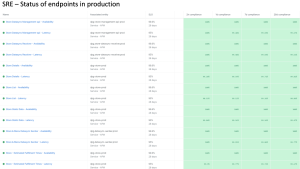In a world where digital transactions drive business revenue, ensuring an exceptional online shopping experience is crucial. The sales season is no exception. During this time, it's essential that the online experience remains robust and reliable. By using observability capabilities during this critical time, you can enhance the user experience and drive revenue growth, all while reducing the risk of performance issues.
The importance of observability
Observability is more than just a buzzword; it's a strategic approach to understanding your entire system's performance. According to our latest Observability Forecast report, 62% of organizations reported that outages cost them at least $1 million per hour in downtime. By enhancing observability, businesses reported experiencing up to 29% growth in revenue and operations. Companies like Kmart, Skyscanner, and Shutterstock are leveraging New Relic’s observability tools to improve their systems and customer experiences to:
- Reduce incidents and downtime. One of the key advantages of observability is the ability to reduce incidents and minimize downtime. A single pane of glass for full stack observability provides comprehensive insights into various tech stacks like AWS and Kubernetes. This full visibility drastically reduces mean time to recovery (MTTR), resulting in less downtime and enhanced customer satisfaction.
- Understand the customer journey. Observability gives you the power to see through the eyes of your customers. Whether it’s using Core Web Vitals to monitor site performance or distributed tracing to manage traffic surges, understanding customer behavior is essential. Platforms like Thortful use distributed tracing to ensure seamless user experiences, capturing and analyzing every interaction across the site.
- Prepare ahead of time. Proactive preparation is the backbone of a successful sales season. By deploying multiple observability capabilities, you can test various user journeys and ensure your system is ready for high traffic. Retailers like Kmart use application performance monitoring, browser monitoring, and synthetics to simulate user journeys and tailor their systems for peak performance during busy sales periods.
Strategies for optimizing performance
Enhance your observability and ensure a successful sales season by using:
Core Web Vitals
Fast load times and interactive sites are critical. Kurt Geiger uses New Relic’s dashboards to track Largest Contentful Paint (LCP) and Time to Interactive (TTI), enhancing customer shopping experience. Kurt Geiger prioritized Google's Core Web Vitals to boost website performance, crucial for e-commerce revenue during peak sales periods. By integrating data from Magento with New Relic, they improved their Core Web Vitals score from 45-50 to 85-90, fostering collaboration among SEO, marketing, and engineering teams. This data-driven approach enhanced site speed and customer satisfaction, setting new industry benchmarks.
Full stack observability
Implement end-to-end monitoring to reduce downtime. With New Relic, M&S has significantly improved their incident management processes by visualizing their entire tech ecosystem. Our Observability Forecast report showed that organizations with full stack observability experience 79% less downtime per year, saving $42 million each year. But to date, only a quarter (24.9%) of those surveyed said they had full stack observability in place. Retailers like UK brand Marks and Spencer, now known as M&S, shifted to full stack observability on New Relic, with insights into AWS, Kubernetes, and their full suite of microservices.
Distributed tracing and synthetics
Manage traffic peaks with precision. Thortful’s approach allows them to address issues before they impact the customer, ensuring high performance even during peak times. Distributed tracing allows Thortful teams to capture, visualize, and analyze interactions throughout the website. Thortful has set up synthetic scripts that define typical user journeys for customers on their site, and can even be alerted and respond to issues raised before even a single user experiences a similar challenge when making their purchases.
Multiple observability capabilities
Kmart leverages a suite of observability tools, from application performance to synthetics monitoring, ensuring their systems are primed for both expected and unexpected sales bursts. In this year’s Observability Forecast, 75% of respondents deployed at least five observability capabilities, and 37% deployed 10 capabilities. This number is expected to climb as more organizations get value from observability and see how it helps sales and revenue growth. Kmart uses application performance monitoring to identify anomalies, browser monitoring for full visibility into web page performance, synthetics monitoring to monitor and simulate user journeys, and Slack integration to deliver intelligent alerts.
Act now
The upcoming holiday season is the perfect opportunity to implement robust observability practices to safeguard against potential sales losses and lay the groundwork for sustained improvements in customer satisfaction and revenue growth. Incorporate these strategies into your operations and experience the power of observability—it's the gift that keeps giving, all year round.
이 블로그에 표현된 견해는 저자의 견해이며 반드시 New Relic의 견해를 반영하는 것은 아닙니다. 저자가 제공하는 모든 솔루션은 환경에 따라 다르며 New Relic에서 제공하는 상용 솔루션이나 지원의 일부가 아닙니다. 이 블로그 게시물과 관련된 질문 및 지원이 필요한 경우 Explorers Hub(discuss.newrelic.com)에서만 참여하십시오. 이 블로그에는 타사 사이트의 콘텐츠에 대한 링크가 포함될 수 있습니다. 이러한 링크를 제공함으로써 New Relic은 해당 사이트에서 사용할 수 있는 정보, 보기 또는 제품을 채택, 보증, 승인 또는 보증하지 않습니다.


